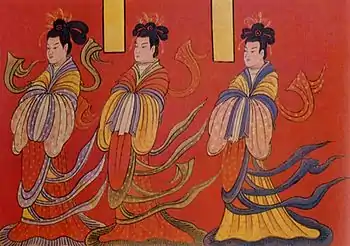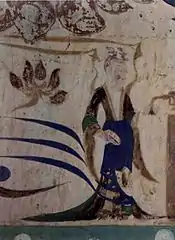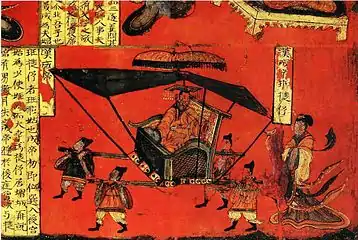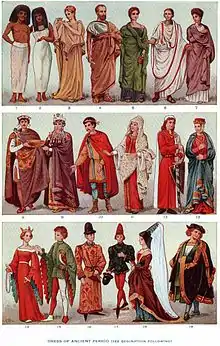Swallow-tailed Hems and Flying Ribbons clothing
Swallow-tailed Hems and Flying Ribbons clothing, or tsa-chü chui-shao fu (traditional Chinese: 雜裾垂髾服; simplified Chinese: 杂裾垂髾服; pinyin: zájū chuíshāo fú; Wade–Giles: tsa2-chü1 chʻui2-shao1 fu2; Zhuyin Fuhao: ㄗㄚˊ ㄐㄩ ㄔㄨㄟˊ ㄕㄠ ㄈㄨˊ) is a type of female historical dress which was popular during the Tsʻao Wei, Chin and Northern and Southern dynasties. It is also called Kui-i (袿衣).

Background
Northern and Southern dynasties was a period of volatility, the barbarians invaded Central Plain, thus, various wars and battles occurred. The once dominant laws and orders collapsed, so did the once unchallenged power of Confucianism. At the meantime, the philosophy of Lao-tzŭ and Chuang-tzŭ became popular. Buddhist scriptures were translated, Taoism was developed, and Humanitarian ideology emerged among the aristocrats. However, all these posed a threat to the conservative and imperial power, which tried to crush them by force. These policies forced these scholars to seek comfort and relief in life.[1] They were interested in various kinds of philosophy and studied a lot of the "mysterious learning". They preferred a life of truth and freedom. They dressed themselves in free and casual elegance.


On the whole, the costumes of the Wei and Chin period still followed the patterns of Chʻin and Han. Women's costumes in the period of Wei and Chin were generally large and loose. The carefree life style brought about the development of women's garments in the direction of extravagant and ornate beauty.[1] The upper garment opened at the front and was tied at the waist. The sleeves were broad and fringed at the cuffs with decorative borders of a different colour. The skirt had spaced coloured stripes and was tied with a white silk band at the waist. There was also an apron between the upper garment and skirt for the purpose of fastening the waist. Apart from wearing a multi-coloured skirt, women also wore other kinds such as the crimson gauze-covered skirt, the red-blue striped gauze double skirt, and the barrel-shaped red gauze skirt. Many of these styles are mentioned in historical records.[2] Wide sleeves and long robes, flying ribbons and floating skirts, elegant and majestic hair ornaments,[1] all these became the fashion style of Wei and Chin female appearance.
Formation
_por_Ku_K'ai-Chih._Copia_de_la_dinast%C3%ADa_Sung_(960-1279)_seg%C3%BAn_la_obra_original_del_siglo_%E2%85%A3.jpg.webp)

During the Wei, Chin and the Northern and Southern dynasties, though men no longer wore the traditional one-piece garment, some women continued to do so. However, the style was quite different from that seen in the Han dynasty. Typically the women's dress was decorated with "hsien" (襳) and "shao" (髾). The latter refers to pieces of silk cloth sewn onto the lower hem of the dress, which were wide at the top and narrow at the bottom, so that triangles were formed overlapping each other. "Hsien" refers to some relatively long ribbons which extended from the short-cut skirt.[2] While the wearer was walking, these lengthy ribbons made the sharp corners and the lower hem wave like a flying swallow, hence the Chinese phrase "beautiful ribbons and flying swallowtail" (華帶飛髾).
During the Northern and Southern dynasties, costumes underwent further changes in style. The long flying ribbons were no longer seen and the swallow-tailed corners became enlarged. As a result, the flying ribbons and swallow-tailed corners were combined into one.[3]
Gallery
 Mo-kao fresco of a woman dressing in tsa-chü chui-shao-fu, Western Wei dynasty (535–557)
Mo-kao fresco of a woman dressing in tsa-chü chui-shao-fu, Western Wei dynasty (535–557) Virtuous women of ancient Cathay (China), lacquer painting
Virtuous women of ancient Cathay (China), lacquer painting Women dressing in tsa-chü chui-shao fu, a lacquer painting over a four-panel wooden folding screen, 5th century
Women dressing in tsa-chü chui-shao fu, a lacquer painting over a four-panel wooden folding screen, 5th century Consort Pan and Emperor Chʻêng of Han, Consort Pan wearing a tsa-chü chui-shao fu
Consort Pan and Emperor Chʻêng of Han, Consort Pan wearing a tsa-chü chui-shao fu Female figures dressing in tsa-chü chui-shao clothing, 5th century
Female figures dressing in tsa-chü chui-shao clothing, 5th century The virtuous women in Cathayan (Chinese) history, 5th century
The virtuous women in Cathayan (Chinese) history, 5th century_2.jpg.webp) Admonitions of the Court Instructress (detail) by Ku Kʻai-chih
Admonitions of the Court Instructress (detail) by Ku Kʻai-chih_4.jpg.webp) Admonitions of the Court Instructress (detail) by Ku Kʻai-chih
Admonitions of the Court Instructress (detail) by Ku Kʻai-chih_6.jpg.webp) Admonitions of the Court Instructress (detail) by Ku Kʻai-chih
Admonitions of the Court Instructress (detail) by Ku Kʻai-chih_7.jpg.webp) Admonitions of the Court Instructress (detail) by Ku Kʻai-chih
Admonitions of the Court Instructress (detail) by Ku Kʻai-chih_1.jpg.webp) Nymph of the Lo River (detail) by Ku Kʻai-chih
Nymph of the Lo River (detail) by Ku Kʻai-chih_2.jpg.webp) Nymph of the Lo River (detail) by Ku Kʻai-chih
Nymph of the Lo River (detail) by Ku Kʻai-chih_3.jpg.webp) Nymph of the Lo River (detail) by Ku Kʻai-chih
Nymph of the Lo River (detail) by Ku Kʻai-chih_4.jpg.webp) Nymph of the Lo River (detail) by Ku Kʻai-chih
Nymph of the Lo River (detail) by Ku Kʻai-chih._Southern_Sung_Copy_of_the_Original_Work_by_Ku_K'ai-chih._Freer_Gallery_of_Art%252C_Washington_D.C.jpg.webp) Nymph of the Lo River (detail) by Ku Kʻai-chih
Nymph of the Lo River (detail) by Ku Kʻai-chih Modern pictorial reconstruction of tsa-chü chui-shao clothing as in Admonitions of the Court Instructress and Nymph of the Lo River
Modern pictorial reconstruction of tsa-chü chui-shao clothing as in Admonitions of the Court Instructress and Nymph of the Lo River
Further reading
- Chunming, Gao (October 1987). 5000 Years of Chinese Costumes. Zhou Xun, Chunming Gao (eds.) (First English language ed.). San Francisco, CA: China Books & Periodicals. ISBN 978-0-8351-1822-4.
- Steele, Ms Valerie; Major, John S. (1999-02-08). China Chic: East Meets West (1st Printing ed.). New Haven: Yale University Press. ISBN 978-0-300-07930-2.
- Finnane, Antonia (2008-01-24). Changing Clothes in China: Fashion, History, Nation (1 ed.). New York: Columbia University Press. ISBN 978-0-231-14350-9.
